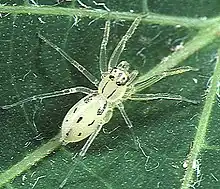Asemonea maculata
Asemonea maculata is a species of jumping spider in the genus Asemonea that is endemic to Ivory Coast. The spider was first defined in 1980 by Fred Wanless. It is a small spider, with a carapace that is between 2.08 and 2.10 mm (1⁄16 and 1⁄16 in) long and an abdomen typically 2.4 mm (1⁄8 in) long. The carapace is amber to whitish-yellow and the abdomen whitish-yellow, both with black markings. It is similar to the related species Asemonea pinangensis and Asemonea tanikawai, but can be distinguished by the tibia on the male pedipalp. The female has not been described.
| Asemonea maculata | |
|---|---|
 | |
| A spider of the Asemonea genus | |
| Scientific classification | |
| Domain: | Eukaryota |
| Kingdom: | Animalia |
| Phylum: | Arthropoda |
| Subphylum: | Chelicerata |
| Class: | Arachnida |
| Order: | Araneae |
| Infraorder: | Araneomorphae |
| Family: | Salticidae |
| Genus: | Asemonea |
| Species: | A. maculata |
| Binomial name | |
| Asemonea maculata Wanless, 1980 | |
Taxonomy
Asemonea maculata is a jumping spider that was first described by Fred Wanless in 1980.[1] He allocated the species to the genus Asemonea, first raised by Octavius Pickard-Cambridge in 1869. The genus is related to Lyssomanes.[2] Molecular analysis demonstrates that the genus is similar to Goleba and Pandisus.[3] In Wayne Maddison's 2015 study of spider phylogenetic classification, the genus Asemonea was the type genus for the subfamily Asemoneinae, split from Lyssomaninae.[4] A year later, in 2016, Jerzy Prószyński named it as the type genus for the Asemoneines group of genera, which was also named after the genus.[5]
Description
The spider is small, with a typical total length of between 4.56 and 4.7 mm (3⁄16 and 3⁄16 in). The male has a carapace that is between 2.08 and 2.10 mm (1⁄16 and 1⁄16 in) long and typically 1.8 mm (1⁄16 in) wide.[6] It is generally pale amber in colour, tending towards a more whitish-yellow in the eye field. The majority of the eyes are surrounded by black markings. The clypeus is pale yellow with a dark band across it and a thin covering of white hairs. The chelicerae, labium and the remainder of the mouthparts are pale yellow. The sternum is a shiny whitish-yellow. The abdomen is whitish-yellow with black spots and slightly iridescent.[7] It is typically 2.4 mm (1⁄8 in) long.[6] The spinnerets are whitish-yellow, as are the legs, although these have black stripes and other dark markings. The pedipalp is distinctive, particularly the enlarged tibia.[7] The female has not been described.[1]
The species is similar in colour to Asemonea murphyi, particularly in the spots and bars on its abdomen.[8] The spider also resembles both Asemonea pinangensis and Asemonea tanikawai but differs in the form of its pedipalp.[9]
Behaviour
Asemonea spiders rarely jump. Instead, they generally walk and run. They spin sheet webs on the underside of leaves, where they also lay their eggs.[10] Although predominantly a diurnal hunter, the spider is also likely to eat nectar if it is available.[11][12]
Distribution and habitat
Asemonea maculata is endemic to Ivory Coast.[1] The holotype was found near the Bandama River in vegetation.[6]
References
Citations
- World Spider Catalog (2018). "Asemonea maculata Wanless, 1980". World Spider Catalog. 19.0. Bern: Natural History Museum. Retrieved 30 June 2018.
- Jackson 1990, p. 1.
- Maddison 2015, p. 236.
- Maddison 2015, p. 235.
- Prószyński 2017, p. 122.
- Wanless 1980, p. 234.
- Wanless 1980, p. 233.
- Wanless 1980, p. 232.
- Ikeda 1996, p. 116.
- Jackson 1990, p. 2.
- Richman & Jackson 1992, p. 33.
- Jackson et al. 2001, p. 28.
Bibliography
- Ikeda, Hiroyoshi (1996). "A new species of the genus Asemonea (Araneae: Salticidae) from Japan". Acta Arachnologica. 45 (2): 113–117. doi:10.2476/asjaa.45.113. Retrieved 20 September 2023.
- Jackson, Robert R. (1990). "Comparative study of Lyssomanine jumping spiders (Araneae: Salticidae): Silk use and predatory behaviour of Asemonea, Goleba, Lyssomanes, and Onomastus". New Zealand Journal of Zoology. 17 (1): 1–6. doi:10.1080/03014223.1990.1042257.
- Jackson, Robert R.; Pollard, Simon D.; Nelson, Ximena J.; Edwards, G. B.; Barrion, Alberto T. (2001). "Jumping spiders (Araneae: Salticidae) that feed on nectar". Journal of Zoology. 255 (1): 25–29. doi:10.1017/S095283690100108X.
- Maddison, Wayne P. (2015). "A phylogenetic classification of jumping spiders (Araneae: Salticidae)". The Journal of Arachnology. 43 (3): 231–292. doi:10.1636/arac-43-03-231-292. S2CID 85680279.
- Prószyński, Jerzy (2017). "Pragmatic classification of the World's Salticidae (Araneae)". Ecologica Montenegrina. 12: 1–133. doi:10.37828/em.2017.12.1.
- Richman, David B.; Jackson, Robert R. (1992). "A review of the ethology of jumping spiders (Araneae, Salticidae)". Bulletin of the British Arachnology Society. 9 (2): 33–37.
- Wanless, Fred R. (1980). "A revision of the spider genera Asemonea and Pandisus (Araneae: Salticidae)". Bulletin of the British Museum (Natural History) Zoology. 39 (4): 213–257. doi:10.5962/bhl.part.13273.